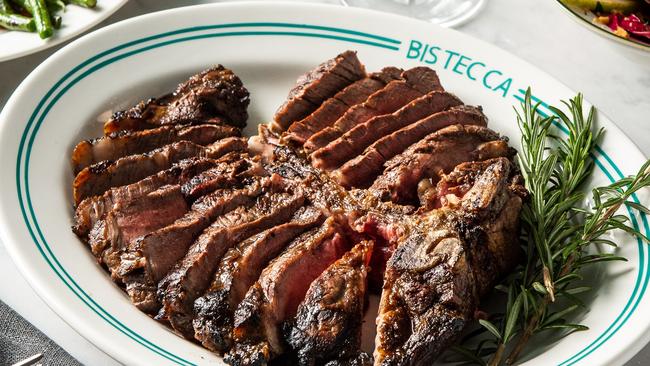Bistecca alla Fiorentina: have a red-hot go
I had a red-meat epiphany 18 years ago with a Bistecca alla Fiorentina in Tuscany. Could I hope to recreate it at home?

Once upon a time, in a world different to the one we now know, there existed a fabulous thing called The Junket. To today’s young media practitioner it must seem highly implausible: influencers of their day – print journalists – ferried to far-flung lands with magnificent itineraries provided by vendors hoping to curry editorial favour.
In 2021, for so many reasons, this seems ridiculous, but being able to at least fondly remember The Junket is one of the few good things about time’s relentless march. And it was on such a trip, hosted by an Italian mineral water company owned by Nestlé (aren’t they all?), that the red-meat epiphany of the true Bistecca alla Fiorentina occurred some 18 years back.
In a little restaurant somewhere near the Mugello motor racing circuit in Tuscany a most amazing – I’m guessing at least 2kg – Chianina piece of meat on the bone came to the table, and for me it redefined the T-bone forever. Mr Nestlé undoubtedly had to shift a few pallets of water to pick up the bill, bless him, but for what it’s worth, it made an impression.
I’ve had Chianina beef in Italy subsequently (part of that other now seemingly mythical phenomenon, the Self-Funded Overseas Holiday) and it was superb, properly cooked over coals in a marvellous setting near San Gimignano. But the memory of that first magnificent, bloody, wood-grilled single joint of beef – tender fillet muscle on the smaller side of the bone and a juicy sirloin the other – is indelible. It made me wonder: how did the Australian T-bone of my youth – a thin-cut piece of flabby, cheap, immature beef stewed on anonymous barbecue hot plates – stray so far from its Italian cousin? It’s the muscle-and-bone equivalent of the skinny, mysterious Bunnings snag and its juicy, pure pork progenitor.
I wandered into my good butcher the other day and there in the ageing cabinet were huge pieces of great-looking 30-day aged Angus T-bone, ready to be cut to order. I felt my inner Florentine surface. The butcher cut me a single piece – 1.04kg including bone, just enough for two – and I came home determined to replicate the best steak I’ve eaten in Australia, the bistecca at… Bistecca, in Sydney. I was already $66 ahead and all I had to do was provide the charcoal and technique. Basically, not stuff it up.
A real, Tuscan bistecca from Chianina beef is eaten very rare; the meat is particularly lean. Although these cattle are grazed in Australia, you’ll be lucky to find the meat. An Angus T-bone, from the animal’s back, will work well but takes a little longer. It should be a minimum of two fingers thick, preferably three to four; and, according to author Emiko Davies’ lovely book Florentine, is served without condiments. Her advice: cook the steak from room temperature; don’t season beforehand; and if you have a charcoal/wood-burning cooker, fire it up. If not, a cast-iron frying pan at very high heat will work.
The target internal temperature for the sirloin part of the T-bone should be 58C for medium-rare, which means the fillet side will be slightly closer to medium, says meat guru Anthony Puharich of Vic’s Meat. An authentic bistecca, in Tuscany, may only be cooked four or five minutes either side, the centre of the beef just warm.
I went the internal temp route, over binchotan-style charcoal broken up into lumps, and it worked a treat, having rubbed the meat with a little oil first. It went from 1004g to 711g during the cooking; yes, there was a fair bit of fat on the cut. Some olive oil, black pepper and salt are considered kosher as condiments; even a squeeze of lemon. Maybe, but I never met a piece of grilled beef that didn’t bond with Dijon mustard, horseradish, or both.
As good as Bistecca’s, or indeed the carnal temptation of Tuscany all those years ago? Maybe not. But with a glass of something red and the lights down low, it reminded me of better times; they will come again. The Junket, I fear, is an extinct species. But better to have loved and lost.
lethleanj@theaustralian.com.au



To join the conversation, please log in. Don't have an account? Register
Join the conversation, you are commenting as Logout